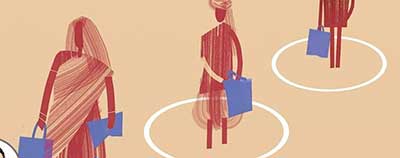Relevance: GS-2:Welfare Schemes for Vulnerable Sections of the population by the Centre and States and the Performance of these Schemes;
Key Phrases: PMGKAY, PDS, NFSA, Rights based approach from Welfare based approach; Chhattisgarh’s PDS reform.
Context:
- PMGKAY (PM Gareeb Kalyan Anna Yojana) and provisions under
National Food Security Act 2013 through Public Distribution System provided
food security to significant rural and urban population during pandemic.
- PMGKAY was one of the many immediate measures as a part of bouquet of social safety measures in order to provide social safety net to vulnerable households.
- But this intervention was made possible due to high production of foodgrains and low commodity prices, which calls for a relook due to change in the status quo.
Key Highlights
- Rationale for success of interventions against hunger and malnutrition.
- Agriculture Sector outperformed other sectors
- During the various lockdowns , farmers
- Harvested their standing rabi crop from late March 2020.
- Aggressively planted for the next two seasons.
- During the various lockdowns , farmers
- Agriculture was the only sector to grow 3.3% in 2020-21 (overall economy contracted by 4.8%).
- As per CMIE’s, the farm sector added 11 million jobs (2019-20 to
2021-22).
- During these three years, the rest of the economy shed 15 million jobs.
- The most significant achievement in FY 21 and 22 was India’s public
distribution system (PDS) truly coming of age and delivering at a time of
crisis.
- Sales of rice and wheat under various government schemes totalled 92.9 million tonnes (mt) in 2020-21 and 105.6 mt in 2021-22.
- Comparing this with previous average offtake
- 62.5 mt during the first seven years after the implementation of the National Food Security Act (NFSA) in 2013-14 and
- 48.4 mt in the seven years preceding the legislation.
About NFSA and PMGKAY
- The NFSA legally entitled 75% of India’s rural and 50% of the
urban population.
- From welfare to rights based approach.
- Approx 813.5 million people receive 5 kg of grain per person
per month at highly subsidised rates of
- Rs 2/kg for wheat,
- Rs 3/kg for rice and
- Rs 5/kg for pulses
- PMGKAY was implemented for eight months (April-November) in 2020-21
and 11 months (May-March) of 2021-22.
- Gave NFSA beneficiaries 5 kg grain per person per month free of cost (Over and above NFSA entitlements).
- One kg Chana (Pulses) to every household.
- Till the early 2000s, only a few states (Kerala, TN and AP), had well-functioning PDS.
- In the late-2000s, Chhattisgarh initiated reforms
- This was followed by Odisha, MP and West Bengal.
Case Study: Chhattisgarh’s PDS Reforms
- Curbing diversion/leakages by entrusting the running of FPS (fair price shops) to cooperatives and local bodies (instead of private licensees),
- Timely allocation
- Supplying grain directly to PDS outlets (bypassing middle-level distribution agencies),
- Using IT to track dispatches right from procurement centres to points of sale.
Translation of Food Security to Political Wins
- Success stories of ensuring the right to food paid off politically as well.
- Chhattisgarh saw the win of incumbent ruling party.
- Successive wins in 2008 and 2013 Assembly elections under Raman Singh, who earned the sobriquet “Chawal Waale Baba (rice monk)”.
- West Bengal saw re-election of Mamta Bannerjee with an enhanced majority in the 2016 West Bengal polls.
- UP saw re-election on the back of the government’s focus on not just expanding the reach of the PDS, but also last-mile delivery of grain to the intended beneficiaries.
Achievements:
- A stark change in handling crisis.
- PDS delivered both when and where it mattered.
- Unlike the 1943 Bengal or 1966-67 Bihar famines, Covid-19 - India’s first major national disaster not to record widespread starvation.
- People in the poorest states got something to eat amid massive job and income losses.
- Provision of social safety net.
- The PDS was the only effective social safety net during the pandemic.
- Specific variations from state to state.
- Kerala leveraged its PDS network to supply free food kits to all ration card holders during form August 2021.
- These monthly kits contain items (from coconut oil, pulses, sugar and salt to tea, coriander, turmeric, chilli powder and soap) on top of PDS allocation.
Challenges:
- Due to the superabundance of rice and wheat in government granaries, PDS
could be expanded.
- Official wheat procurement is likely to halve this time from last year’s record 43.3 mt, due to crop loss by the abnormal march temperature.
- Rice stocks are stocked aplenty but the precarious supply situation in fertilisers raises questions about the prospects for the coming kharif season.
- It would be difficult to pull off the success of PMGKAY due to low procurement, but in the meantime PDS level procurement (60-65 mt) could be maintained.
- Rising food inflation could significantly increase the procurement cost.
Conclusion:
- The golden chapter of the PDS was scripted in an environment of low global commodity prices and surplus domestic foodgrain production.
- The PDS was originally meant to protect ordinary people from extraordinary price rises. Whether it can do that at a time of renewed global inflation remains to be seen.
Source: The Indian Express
Mains Question
Q) Explain the provisions of PM Gareeb Kalyan Anna Yojana. What are its achievements and the challenges faced in the present time?







